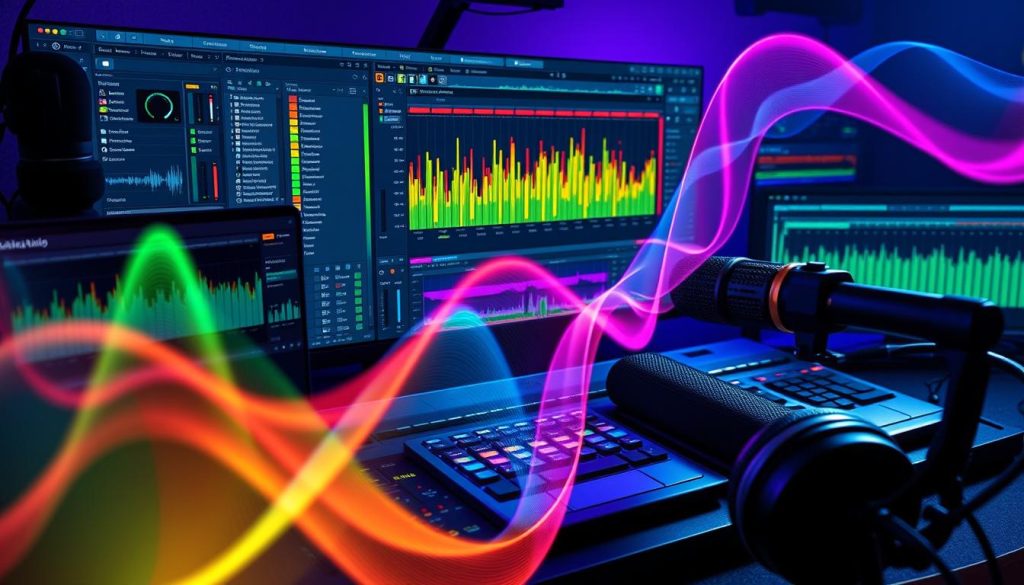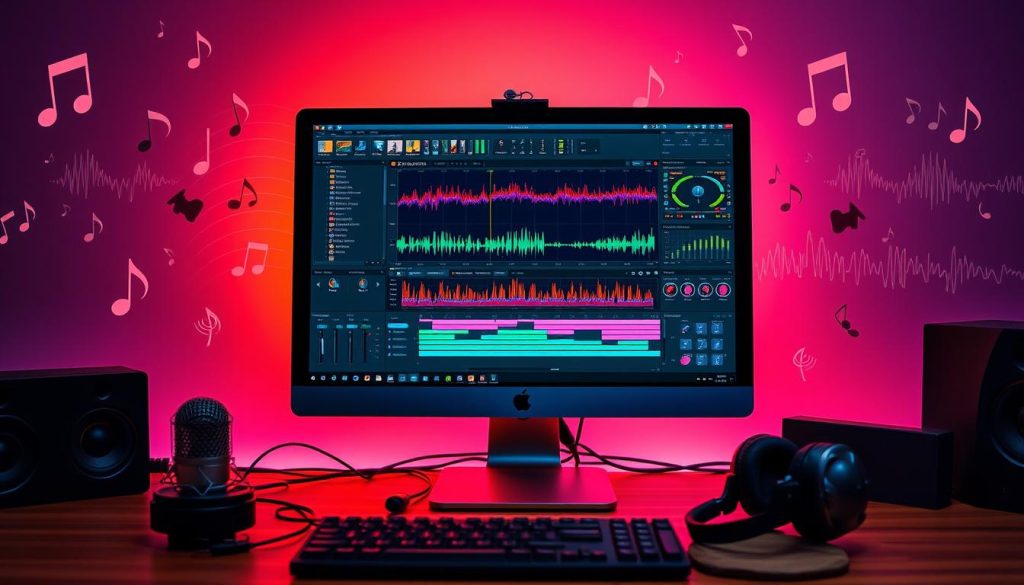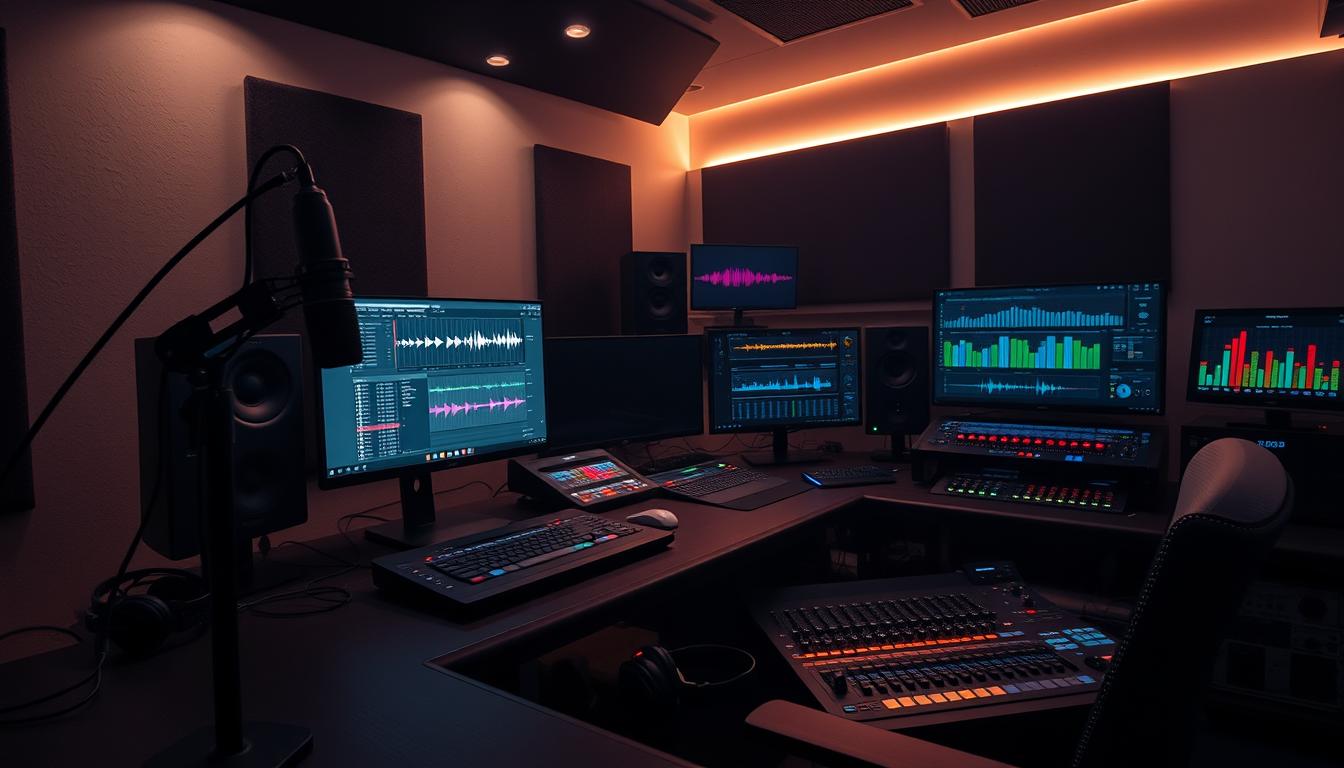High-end audio production tools can be pricey, but there are many free options that are just as good. These tools let anyone make professional-quality audio at home. I’ll show you the best audio editing software, their main features, and who they’re good for.
Whether you’re into podcasting, making music, or creating content, you’ll find the right tools here. You’ll learn how to make your audio sound perfect and flawless.
Introduction to Audio Editing Software
Audio editing changes sound recordings. It can change speed, length, quality, and volume. This is done with software, like a digital audio workstation (DAW). It lets users cut, fade, and mix audio files to get the right sound.
What is Audio Editing?
Audio editing makes audio recordings better. It’s about making small changes to sound files. This includes changing volume, pitch, and timing. It’s key for making podcasts, music, or videos sound great.
Types of Audio Edits
There are three main types of edits in audio editing:
- Cutting: Removing parts of an audio file to make it shorter and smoother.
- Fading: Slowly turning up or down the volume at the start or end of a clip for a smooth sound.
- Mixing: Putting together different audio files into one piece by adjusting their levels.
These basics and techniques are crucial for making great audio. They help you make professional-sounding recordings.
How Audio Editing Works

Audio editing uses digital audio workstations (DAWs) as key tools. These tools help users improve their audio recordings. The main steps in audio editing are:
- Selection – Finding the audio part that needs editing.
- Editing – Changing the audio as needed, like cutting or rearranging it.
- Processing – Adding effects and making adjustments, such as filters or volume changes.
- Output – Saving the edited audio in the right format for sharing or further use.
These steps help audio experts and fans make their audio perfect. By using DAWs, they can easily edit audio and make it sound great. This way, they can bring their creative ideas to life and get professional-quality results.
| Audio Editing Step | Description |
|---|---|
| Selection | Identifying the specific audio clip or section that needs to be edited. |
| Editing | Making the desired changes, such as trimming, splicing, or rearranging the audio. |
| Processing | Applying various effects and adjustments to the audio, like filters, equalization, or volume normalization. |
| Output | Saving the edited audio in the appropriate file format for further use or distribution. |
Benefits of Using Audio Editing Software

Using audio editing software has changed the game for me as an audio content creator. It has many benefits that have made my audio work much better.
One big plus is making my audio sound better. With these tools, I can easily get rid of background noise and make the sound louder. I can also make it clearer and crisper. This makes my listeners enjoy a professional sound.
Another big plus is saving time. These tools let me do tasks automatically, like applying sound filters. This means I can spend more time on being creative, not stuck on technical stuff.
Also, these tools give me a lot of flexibility. I can make different versions of a project without harming the original. This lets me try out ideas and improve my work until it’s just right. Having this control is key to making great audio content.
| Advantages of Audio Editing Software | Description |
|---|---|
| Improved Audio Quality | Ability to remove background noise, boost volume, and enhance overall clarity |
| Time-Saving | Automates tasks like applying filters, leveling, and clipping files |
| Flexible Content Creation | Allows for creating multiple versions of a project without damaging the original |
In conclusion, audio editing software has many benefits. It helps me make better audio, save time, and control my creative process. For an audio content creator, these benefits are very important. They help me give my audience a top-notch listening experience.
audio editing software: A Beginner’s Guide
Starting your audio editing journey is exciting and rewarding. It’s key to know the essential tips and techniques for success. As a beginner, keep these important points in mind during the editing process.
9 Audio Editing Tips for Beginners
- Begin with high-quality recordings. Editing can’t fix poor-quality audio, so make sure your recordings are clean and clear.
- Pick the right audio editing software for your level. Look for a tool that fits your needs and is easy to use.
- Know how to adjust volume levels. Proper volume control is key for a balanced and professional sound.
- Use fade-ins and fade-outs for smooth transitions between clips.
- Add background noise carefully to set the scene.
- Be careful with filters and effects. Too much can ruin the real sound of your audio.
- Keep your project organized with folders for easy access and better workflow.
- Use looping to extend audio without losing quality.
- Clean up the final track by removing unwanted noises for a professional finish.
Follow these tips for beginners to improve your audio editing skills. With practice and hard work, you can make audio that really connects with people.
Top Audio Editing Software Solutions
Finding the best audio editing software isn’t easy. Different programs offer various features, ease of use, and prices. They meet the needs of professionals, hobbyists, and content creators. Let’s look at the top options, as ranked by G2’s Summer 2024 Grid® Report.
G2 Grid® for Audio Editing Software
The G2 Grid® is a trusted source. It ranks software based on user reviews, market presence, and more. Their latest report lists the top audio editing software solutions:
- Adobe Audition
- Audacity
- Pro Tools
- GarageBand
- Logic Pro
| Software | Ease of Use | Features | Pricing |
|---|---|---|---|
| Adobe Audition | 4.5/5 | 5/5 | $20.99/month |
| Audacity | 4.7/5 | 4/5 | Free |
| Pro Tools | 4.3/5 | 5/5 | $30/month |
| GarageBand | 4.8/5 | 4.5/5 | Free |
| Logic Pro | 4.6/5 | 5/5 | $199.99 one-time purchase |
Looking for professional audio editing software or something for hobbyists? Want the best value? This G2 Grid® breakdown will guide you. It helps you choose the right audio editing tool for your needs.
Sound Mixer Software for Perfecting Your Audio
As an audio enthusiast, I’ve found sound mixer software key in audio production. These tools help me mix and master tracks perfectly. They make my soundscapes for media projects stand out.
Software like Kingshiper Audio Editor and Adobe Audition, Ableton Live 11, Pro Tools, and FL Studio are top choices. They offer features like multi-track editing and real-time effects. Their user-friendly interfaces make them great for anyone.
These programs are great for both new and experienced audio engineers. They let me blend tracks, add effects, and fine-tune the mix easily. This makes my projects sound amazing and engaging.
Using sound mixing software helps me improve my audio skills. These programs let me make small tweaks or big changes. They turn my audio ideas into reality. With each project, I learn more and explore new audio possibilities.

